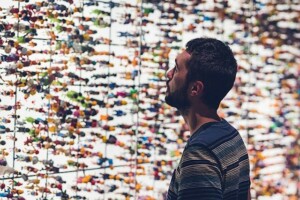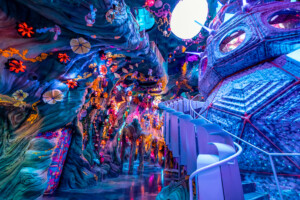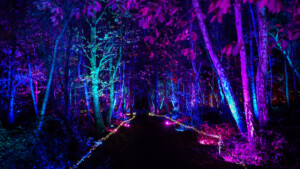Warren Baverstock (below) is Aquarium Curator of the world’s most luxurious hotel, Jumeirah’s Burj Al Arab in Dubai, UAE and a renowned underwater photographer. He is responsible for not only the iconic hotel’s aquarium exhibits but also for 
 developing Jumeirah’s marine conservation policy.
developing Jumeirah’s marine conservation policy.
Warren and his team are driving forward a number of ground breaking conservation initiatives and he was instrumental in starting the region’s only sea turtle rehabilitation project which has successfully rescued, rehabilitated and released over 600 sea turtles. His stunning photography has also featured in publications focusing on underwater life in the Middle East.
Charles Read spoke with him about his career, the aquariums at Burj Al Arab and Jumeirah’s commitment to conservation.
See also: Aquariums are good for you! Dr Dave Gibson, MD, National Marine Aquarium / Rob Hicks, Director of Displays Development SEA LIFE, Merlin Entertainments / Ted A. Beattie, CEO, Shedd Aquarium / The Saint Louis Zoo's President and CEO, Jeffrey P. Bonner, Ph.D – Conservation, from Fence to Field / David Kimmel, COO Georgia Aquarium on Exceeding Expectations
How did you get into the aquarium business?
I had always had an interest in aquatic life. As a kid I used to snorkel in the rivers on the moors (Dartmoor, South Devon), exploring the rivers where I fished. I took a mask, snorkel and fins with me everywhere; it’s amazing what you can see underneath a river bank! When I was young I kept several large marine fish aquarium tanks. I always had the desire to work within the trout farming industry and spent a large amount of my summer holidays working for a local businessman stocking rivers and lakes around Devon. I left to live in Plymouth where I played national league basketball for 8 years until this opportunity arose within the National Marine Aquarium.
During this time I Learnt to dive in Plymouth, – and was encouraged by some colleagues to try diving in Fort Bovisand (South Devon). On a cold November evening, around 4pm, it was getting dark and I did my first try dive. I couldn’t see anything, it was cold but I was hooked, to such an extent that I became a Divemaster in 2 years.

The National Marine Aquarium
I was very keen to work at The National Marine Aquarium (NMA) but as I had no experience as an aquarist the only way I could get in was as a part-time guide. Once working at the aquarium, as soon as the curator Juan Romero found out I could dive, he suggested I could help out as they needed a diver. So I started diving at the aquarium, initially once a week, then up to 5 times a week until I was even coming in and diving on my days off. I loved it, and the feed displays went really well. When a member of staff left, I was formally offered the position of aquarist/diver.
Around that time the NMA was creating the UK’s deepest tank so I was heavily involved in the build right from ground zero. This was an amazing experience. I worked on everything from the construction of the rock work, through to introducing the fish and sand tiger sharks, moving exhibits, moving rays and the relocation of all animals. There was also a massive amount of husbandry work during my time at the NMA, for example, the breeding and rearing of seahorses and running the moor and mountain stream exhibit (a favourite of mine after I spent my childhood exploring the river banks on the moors), so I gained a huge amount of valuable experience there.
You started at Burj Al Arab in 2002, how did this move come about?
Just before I became a guide at the NMA, back in ’99, my wife and I had taken a holiday to Dubai. I remember us sitting on the beach having breakfast and seeing Burj Al Arab. It looked incredible – there were no other buildings or construction sites around. We thought, maybe one day we will be able to live in this amazing city.
The NMA had the contract to run the facility at Burj Al Arab, so there was a connection. I was offered a position to work in Dubai and I jumped at the chance. My wife and I sold everything, we downsized and the whole move was made in 4 months. I began here as an assistant curator and for 2 yrs worked under Dominic Boothroyd , who is currently the General Manager at National Lobster Hatchery in Padstow, Cornwall. I learnt a lot from him. After Dominic moved on, I took over his role as Aquarium Curator.
What were the aquarium’s facilities like when you first joined?
As with any designed aquarium, there is always room for improvement as advancements are made in husbandry, life support systems (LSS), marine biology and technology.  When I took over the role the aquariums were fine, ticking along nicely and the NMA were running it well. However, I made it my personal goal to address any improvements that could be made and I set up a 6 year project to do so.
When I took over the role the aquariums were fine, ticking along nicely and the NMA were running it well. However, I made it my personal goal to address any improvements that could be made and I set up a 6 year project to do so.
Please describe the aquariums at the hotel.
Burj Al Arab has three main exhibits. There are two tanks as you come into the hotel, one on either side of the lobby, each of around 250, 000 litres. Connected to these lobby tanks (they are L shaped) is a private dining area. The hotel is designed in such a way that the behind-the-scenes part of the lobby tank exhibits are part of the private dining experience. We also have the exhibit in Al Mahara, our signature restaurant. It’s an incredible seafood restaurant and is extremely popular with an amazing ambience. The 300, 000 litre aquarium exhibit is oval shaped, the dining tables completely surround it and it is considered Dubai’s most attractive aquarium exhibit.
We also maintain 5 large quarantine facilities. We use these when we are restocking fish but also for the rehabilitation of sea turtles.
And what is the focus in term of species, is it Middle East Specific?
We tend to go for Indian Ocean and Indonesian/ Far East type fish. The Maldives and Sri Lanka are good sources, as are the Red Sea and Saudi Arabia. These locations are relatively close and we know how the people and companies we work with are catching the fish. Their catching ethics are reef safe and this is important to us.
Are there any key differences or benefits to being owned by a large hotel/leisure company as opposed to a stand alone aquarium?

There are no disadvantages. The advantage is that we are keen on staying in the forefront of the industry and we take our position seriously. We invest heavily, not just into life support and the welfare of the animals but also into nutrition. We do review prices and shop around. When it comes to investing and spending money, we ensure that we plan ahead and stay in line with our annual budgets.
Any plans for future developments for the aquarium?
We have just finished retheming, restarting and restocking the lobby tanks. The plan in 2015 is to redevelop the Al Mahara exhibit. I am going to the 2nd International Elasmobranch (sharks) Husbandry Symposium in November at Monterey, California. We will present in Monterey our zebra shark Parthenogenesis project. During this visit I hope to get ideas ready for the refurbishment proposal. It is going to be a big project as it is for our signature restaurant.Conservation
What facilities dedicated to conservation and rehabilitation do you have access to?
Education and conservation are very important to me and I had these values instilled into me during my days at the NMA. In 2004 we were approached by the ruler’s office to set up the Dubai Turtle Rehabilitation project (DTRP). The DTRP is now based at Burj Al Arab and Madinat Jumeirah – our sister property – and is run in conjunction with Dubai’s Wildlife Protection Office.
There are waterways at the Mina A’ Salam (one of the two hotels at the neighbouring Madinat Jumeirah) which are naturally sea fed with a 60 minute turnover. These provide us with an adequate space and natural foraging area for the turtles, so with the introduction of artificial reefs, designed to facilitate sick and injured sea turtles, we were able to create a really great educational and conservation tool. Within Burj Al Arab we have the rehabilitation facility, we have experts in marine biology and the whole project is funded by Jumeirah. Turtles come to us, we rehabilitate them and once satisfied they are at a stage where they can self forage and survive outdoors, we move them over to the Mina A’ Salam for the final stage in their recovery.
We have two turtle pens there; one is designed for small turtles, one for larger turtles. You don’t want to combine both, the big turtles can get in the way and  might bite the smaller turtles. A lot of the sick and injured turtles brought to us have difficulties with positive buoyancy. There can be various causes for this, but the result is that the turtle finds itself at the surface of the water. A turtle has its internal organs at the top of its carapace so being exposed to the heat of the Middle Eastern sun for up to ten hours a day can cause them serious problems. With this in mind we have developed artificial reefs to tackle just this issue. The turtles can dive down and float up, underneath the reef. They can wedge themselves underwater, under the reef, which enables them to recover some degree of normality until the positive buoyancy dissipates. This is a development we are really proud of.
might bite the smaller turtles. A lot of the sick and injured turtles brought to us have difficulties with positive buoyancy. There can be various causes for this, but the result is that the turtle finds itself at the surface of the water. A turtle has its internal organs at the top of its carapace so being exposed to the heat of the Middle Eastern sun for up to ten hours a day can cause them serious problems. With this in mind we have developed artificial reefs to tackle just this issue. The turtles can dive down and float up, underneath the reef. They can wedge themselves underwater, under the reef, which enables them to recover some degree of normality until the positive buoyancy dissipates. This is a development we are really proud of.
The DTRP has been a massive project for us. 2 yrs ago we had over 350 turtles in 2 and half months, last year 200. This year we had a mild winter. This meant fewer turtles were affected by cold temperatures – less cold stunning – giving any sick or injured turtles an extra chance to recover. We have had 6 this year, so it might be that this is reflection of the water temperature.
The DTRP releases over 3000 turtles a year and creates an amazing opportunity for our guests and visitors to encounter the turtles and learn about our conservation work. We have a huge focus on education and give free education sessions twice a week, speaking to over 5, 000 kids a year. We also have open days.
Last June we had the “Big Jumeirah S ea Turtle race”. This involved Jumeirah’s 6 Dubai based properties – including Wild Wadi Waterpark, Madinat Jumeirah and Burj Al Arab – each releasing their own satellite tagged turtle into the ocean. The tagging allowed each hotel and their guests to follow and track the movements of the turtle and a prize was awarded to the hotel whose turtle had travelled the furthest after 6 months. At the same time 101 juvenile Hawksbill Turtles were released by local school children. The educational value of this event was enormous, with colleagues and guest at the Jumeirah properties involved in the release and over 2000 people in attendance that morning to experience the release of the turtles.
ea Turtle race”. This involved Jumeirah’s 6 Dubai based properties – including Wild Wadi Waterpark, Madinat Jumeirah and Burj Al Arab – each releasing their own satellite tagged turtle into the ocean. The tagging allowed each hotel and their guests to follow and track the movements of the turtle and a prize was awarded to the hotel whose turtle had travelled the furthest after 6 months. At the same time 101 juvenile Hawksbill Turtles were released by local school children. The educational value of this event was enormous, with colleagues and guest at the Jumeirah properties involved in the release and over 2000 people in attendance that morning to experience the release of the turtles.
We had a lot of fun when we did the turtle release with Novak Djokovic – the world’s number one tennis player. We came up with this idea together with the Dubai Duty Free Tennis Championship (DDF) team. Novak showed great interest in our work and was very keen to see and learn more about our rehabilitation project. We organised a show around for him and had him feed the sharks.
We had a hawksbill turtle which was recovering and we asked Novak to give him a name before we release him back to his environment. He named it Leonardo, after his favourite character from the Ninja Turtles cartoon. Novak really connected with the animals, especially Leonardo the turtle, which made the experience far more rewarding for our team. We have a satellite tag ready and we will eventually release Novak’s turtle into the sea. It would be great if he could come back and release Leonardo back to the sea.
Which aquariums do you admire? 
The NMA is a favourite. Also in the UK the London Aquarium is a great facility, as is Hull Aquarium (The Deep). In the UK aquariums take the conservation and education aspects very seriously and this is extremely important to me.
And your work with whale sharks?
Over the last 2 years we have supported the Marine Conservation Society Seychelles (MCSS) whale shark research team. Burj Al Arab has donated our professional experience and both David Robinson, Assistant Aquarium Operations Manager at Burj Al Arab who is doing his PhD on whale sharks in Qatar, and myself, are heavily committed to working with whale sharks alongside the MCSS. We have dedicated time to support the guys in both the Seychelles and on the project work in Djibouti.
Locally, we work with Emirates Diving Association (EDA), on promotion of whale shark conservation but also with whale shark spotting. Lots of people dive with cameras now, so we have produced a lot of material and encouraged people diving with whale sharks to take photographs, so when they dive with the sharks the data goes to David. The work in Qatar is big, they’ve discovered for example that one of the largest aggregations of whale sharks in the world is there. David has already published his first paper for his PhD.
What is the current state of Dubai’s coast line?
In this region there are environmental groups such as the EDA, doing a lot of good work. They patrol beaches and a good number of the turtles brought into us are from them. They do beach cleanup operations, cleaning up old docks, help maintain the mangroves and do a lot of education work. There really is a lot of effort going into protecting and preserving the marine environment here. The Diving around Dubai is about wrecks but in Abu Dhabi it is different , it is about mangroves and small reef areas.
As an accomplished diver and underwater photographer which species do you most enjoy encountering?
In Jordan, I dived on a wreck and for 45 minutes was diving on my own with a dolphin; diving with marine mammals is very special. Snorkelling with whale sharks is also amazing. Diving in the Maldives is also amazing, I dived there for many days and seeing 50 or 60 mantas in a small confined area was just incredible.
Images: Top image – turtle and Burj Al Arab by Simone Caprodossi. Others kind courtesy Burj Al Arab www.jumeirah.com and Warren Baverstock www.warrenbaverstock.com.











